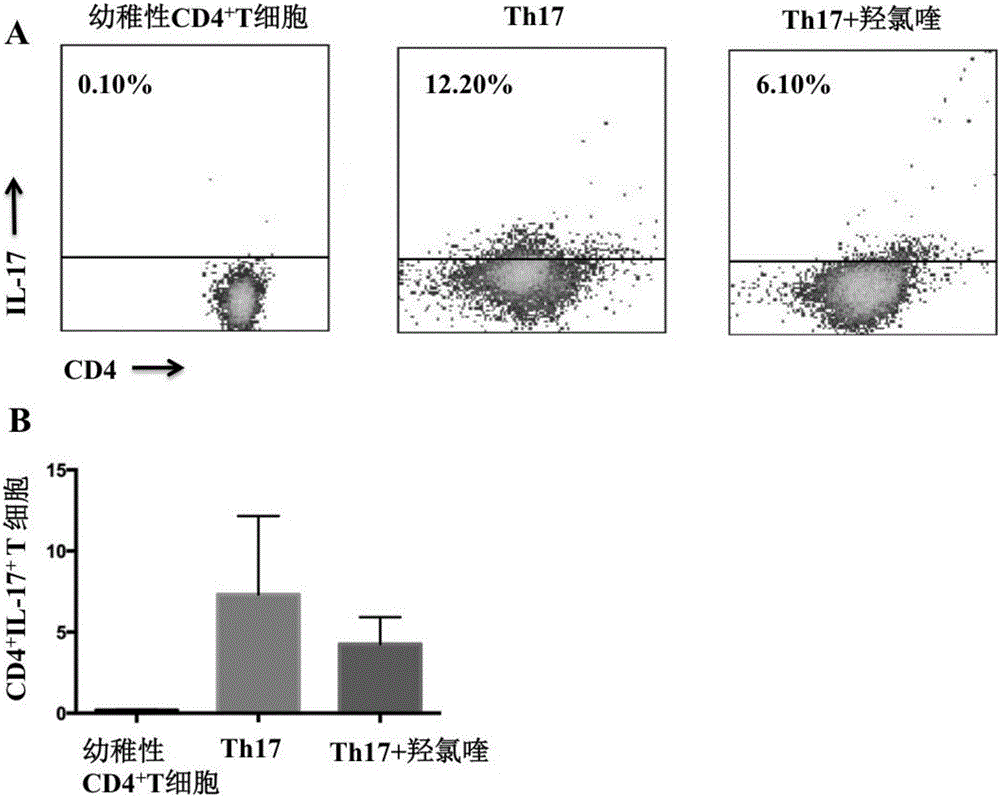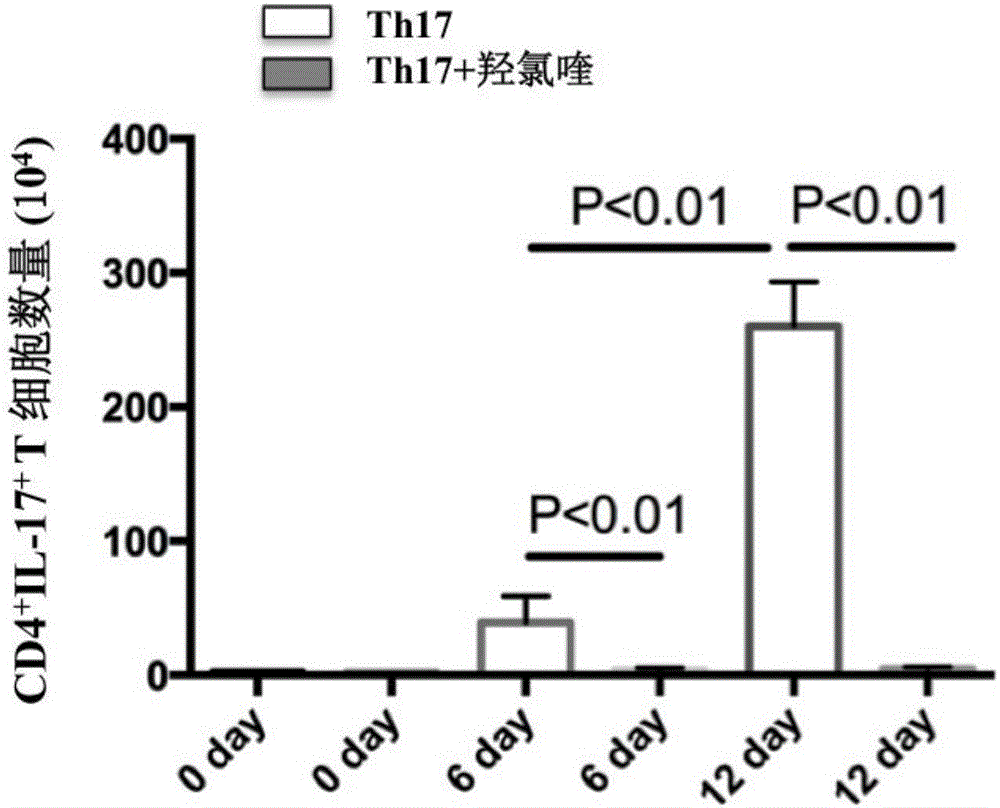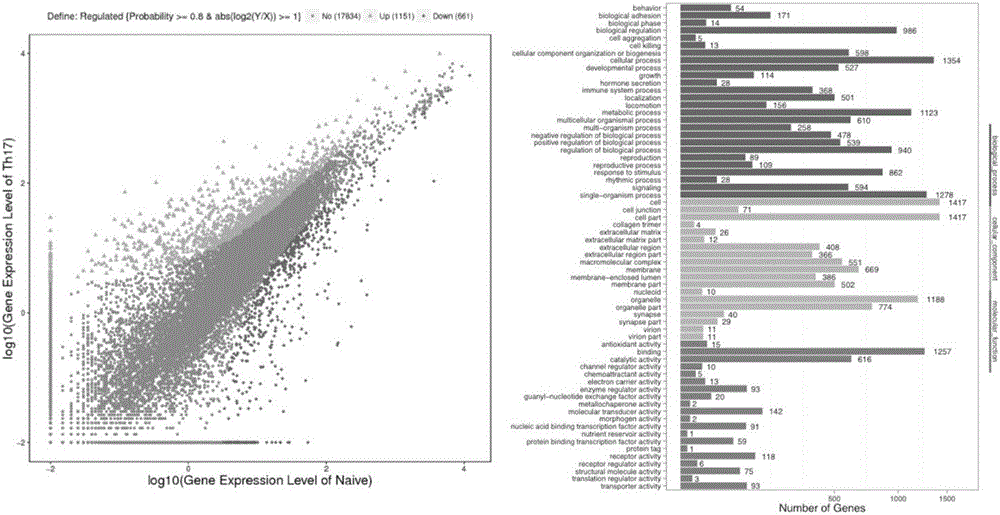Application of micro RNA group related to Th17 differentiation to preparation of drugs for treatment and effect judgment
1. The technology of microrna4426 and arthritis, which is applied in the field of diagnostic reagents for judging the clinical curative effect of hydroxychloroquine, achieves a broad prospect of promotion
- Summary
- Abstract
- Description
- Claims
- Application Information
AI Technical Summary
Problems solved by technology
Method used
Image
Examples
Embodiment 1
[0033] Example 1 Effect of Hydroxychloroquine on Th17 Differentiation of Naive T Cells
[0034] Sorting peripheral blood mononuclear cells from healthy people's peripheral blood, and further sorting CD4 by flow cytometry + Naive T cells were cultured in vitro. On day 0, the sorted naive CD4 + T cells were resuspended in RPMI 1640 medium containing 10% fetal bovine serum, and anti-CD3 / CD28 activated magnetic beads (5 μl / ml), IL-1β (50ng / ml), TGF-β (1ng / ml), IL-6(30ng / ml), IL-23(30ng / ml), anti-IL-4(5ng / ml), anti-IL-12(5ng / ml) and anti-IL-2(20U / ml) Differentiation was induced; on the 6th and 9th days, the medium was changed in half, and the corresponding cytokines were supplemented; on the 12th day, the cells were harvested. In the hydroxychloroquine intervention group, 20 μM hydroxychloroquine was added on the 0th day of culture, and hydroxychloroquine was supplemented when half the medium was changed. The results suggest that naive T cells can be effectively induced to diff...
Embodiment 2
[0035] Example 2 Hydroxychloroquine Time-Dependent Inhibition of Th17 Differentiation of Naive T Cells
[0036] On day 0, the sorted naive CD4 + T cells were resuspended in RPMI1640 medium containing 10% fetal bovine serum, and anti-CD3 / CD28 activated magnetic beads (5 μl / ml), IL-1β (50ng / ml), TGF-β (1ng / ml), IL -6 (30ng / ml), IL-23 (30ng / ml), anti-IL-4 (5ng / ml), anti-IL-12 (5ng / ml) and anti-IL-2 (20U / ml) Differentiation was induced; on the 6th and 12th day, the cells were harvested respectively, and half of the medium was changed on the 6th day in the 12-day group, and the corresponding cytokines and hydroxychloroquine were supplemented. The results suggest that cytokines can induce Th17 differentiation in a time-dependent manner, and hydroxychloroquine can inhibit Th17 differentiation in a time-dependent manner. The result is as figure 2 shown. This figure illustrates that hydroxychloroquine can time-dependently inhibit the conversion of naive T cells to Th17.
Embodiment 3
[0037] Example 3 Differentially expressed genes of naive T cells induced to differentiate into Th17
[0038] Sorting peripheral blood mononuclear cells from healthy people's peripheral blood, and further sorting CD4 by flow cytometry + Naive T cells were cultured in vitro. On day 0, the sorted naive CD4 + T cells were resuspended in RPMI 1640 medium containing 10% fetal bovine serum, and anti-CD3 / CD28 activated magnetic beads (5 μl / ml), IL-1β (50ng / ml), TGF-β (1ng / ml), IL-6(30ng / ml), IL-23(30ng / ml), anti-IL-4(5ng / ml), anti-IL-12(5ng / ml) and anti-IL-2(20U / ml) Differentiation was induced; on the 6th and 9th days, the medium was changed in half, and the corresponding cytokines were supplemented; on the 12th day, the cells were harvested. BGI performed RNA-Seq to understand gene expression. The specific steps are to extract the total RNA of the sample and digest the DNA with DNaseI, enrich the mRNA with magnetic beads containing Oligo(dT), add an appropriate amount of fragment...
PUM
 Login to View More
Login to View More Abstract
Description
Claims
Application Information
 Login to View More
Login to View More - R&D
- Intellectual Property
- Life Sciences
- Materials
- Tech Scout
- Unparalleled Data Quality
- Higher Quality Content
- 60% Fewer Hallucinations
Browse by: Latest US Patents, China's latest patents, Technical Efficacy Thesaurus, Application Domain, Technology Topic, Popular Technical Reports.
© 2025 PatSnap. All rights reserved.Legal|Privacy policy|Modern Slavery Act Transparency Statement|Sitemap|About US| Contact US: help@patsnap.com



